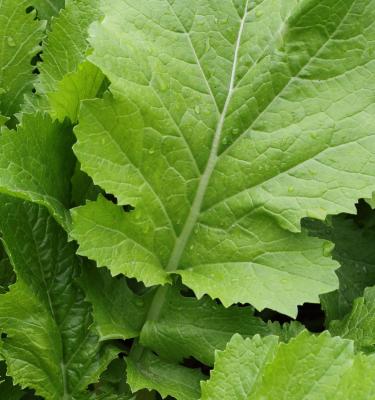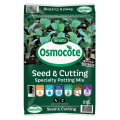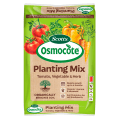

How to grow & care for Mustard Greens
Mustard greens (Brassica juncea) are a cool season vegetable, grown for their peppery edible leaves. You can eat young mustard green leaves raw in salads for a spicy kick or cook older leaves into soups, stews and stir fries for added flavour.
Mustard greens are frost tolerant and fast growing - they’ll be ready to start picking leaves from just 5-6 weeks after planting, making them the perfect crop to grow amongst longer term brassicas like broccoli, cauliflower and cabbage.
Top 5 steps to growing mustard greens
- Choose a full sun or part shade spot to grow mustard greens. They won’t mind dappled shade from surrounding vegetable crops.
- Improve the soil before planting by adding compost or Scotts Osmocote Compost Premium Soil Improver
- Direct sow mustard seeds into prepared soil or start them in Scotts Osmocote Seed & Cutting Potting Mix and transplant into prepared soil once they are big enough to handle.
- Slugs and snails are a big problem for mustard greens crops. Sprinkle Defender Slug & Snail pellets around to keep your crops from attack.
- There's no need to pull up the whole plant when harvesting mustard greens, simply remove a few of the outer leaves from each plant and leave the rest to continue growing.
Shopping List
- Mustard green seeds or seedlings
- Scotts Osmocote Compost Premium Soil Improver
- Scotts Osmocote Plus Organics Tomato, Vegetable & Herb Plant Food & Soil Improver
- If growing from seeds, Scotts Osmocote Seed & Cutting Potting Mix and suitable small pots
- If growing in pots, Scotts Osmocote Plus Organics Tomato, Vegetable & Herb Potting Mix and a suitable pot
- Garden trowel
- Defender Slug & Snail Pellets
- Mulch
Prepare
Choose a full sun to part shade spot for your mustard greens. Mustard greens can be planted amongst longer growing crops like cabbage, cauliflower, broccoli and other cool season vegetables.
Enriched the soil before planting with Scotts Osmocote Compost Premium Soil Improver and a small amount of Scotts Osmocote Plus Organics Tomato, Vegetable & Herb Plant Food & Soil Improver - dig these through the top 10-20cm of soil.
Growing from seeds
Direct sow mustard green seeds into prepared soil in early autumn or start them in punnets in late summer.
Lightly sprinkle the seeds onto the soil surface and cover with 3mm of soil. Keep the soil moist until the seeds germinate. Once the seedlings are 5-10cm tall they can be thinned to the recommended spacing (check the instructions on the seed packet, as each variety will be slightly different).
Mustard green seeds can also be sown into punnets or small pots and transplanted into the garden once large enough. Fill clean punnets or small pots with Scotts Osmocote Seed & Cutting Potting Mix and sprinkle mustard green seeds onto the surface - cover them with 3mm of Scotts Osmocote Seed & Cutting Potting Mix and keep the potting mix moist until the seeds germinate. Once seedlings are 5-10cm tall they can be transplanted into your prepared garden soil or larger pots to grow on.
Planting in the garden
Plant mustard green seedlings into prepared soil at the recommended spacing. If direct sowing seeds into your garden follow the instructions under ‘Growing from seeds’ above.
Mulch around your mustard green plants to suppress weeds and retain moisture. Fertilise with a light sprinkle of Scotts Osmocote Plus Organics Tomato, Vegetable & Herb Plant Food & Soil Improver around each plant 6-8 weeks after planting.
Planting in pots
Mustard greens can easily be grown in medium pots at least 20-30cm deep by the same width.
Fill the pot with Scotts Osmocote Plus Organics Tomato, Vegetable & Herb Potting Mix and either direct sow seeds or plant seedlings. Position your pot in a full sun to part shade spot.
Fertilise with a light sprinkle of Scotts Osmocote Plus Organics Tomato, Vegetable & Herb Plant Food & Soil Improver on the potting mix surface 6-8 weeks after planting.
Regular watering of mustard greens is critical in pots, as small pots in particular can dry out quickly. Mulch the surface of the potting mix around your plants to suppress weeds and retain moisture.
Harvest
Mustard greens will be ready for their first harvest 5-6 weeks after planting.
There’s no need to pull up the whole plant when harvesting mustard greens. Instead remove leaves from the outer part of the plant, leaving the innermost leaves to continue growing. Don’t remove more than 50% of the leaf growth at any one time, so the plant can continue to thrive.
Pests & Diseases
Slugs and Snails will cause significant damage to mustard greens at all stages of its growth. Protect your crop by setting beer traps (saucers filled with beer) or use Defender Snail & Slug Pellets.
White Cabbage Butterfly caterpillars also love eating Mustard Greens leaves - use a wildlife safe, insect exclusion netting over your crop to prevent the flying butterfly from laying its eggs on your mustard greens leaves.



